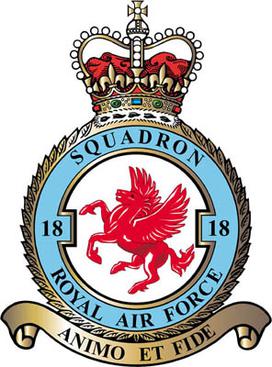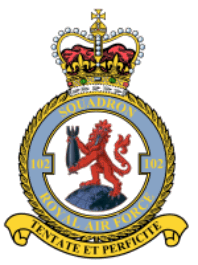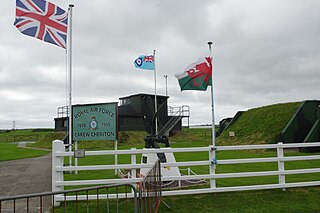
No. 18 Squadron of the Royal Air Force operates the Boeing Chinook from RAF Odiham. Owing to its heritage as a bomber squadron, it is also known as No. 18 (B) Squadron.

Number 13 Squadron, also written as XIII Squadron, is a squadron of the Royal Air Force which operate the General Atomics MQ-9A Reaper unmanned aerial vehicle from RAF Waddington since reforming on 26 October 2012. The unit first formed as part of the Royal Flying Corps on 10 January 1915 and went on to fly the Martinsyde G.100, the Royal Aircraft Factory F.E.2, the SPAD VII and SPAD XIII, the Sopwith Dolphin during the First World War. In Second World War it started out operating the Westland Lysander for army cooperation. From late 1942 it used Blenheims in North Africa but in 1943 squadron converted to Ventura for coastal patrols and convoy escort duties. Post war it operated Mosquito before transitioning to the new jet aircraft Gloster Meteor and English Electric Canberra for photoreconnaissance. From 1 January 1990, it operated the Panavia Tornado, initially the GR1A at RAF Honington and later the GR4/4A at RAF Marham where it temporarily disbanded on 13 May 2011.

No. 220 Squadron of the Royal Air Force (RAF) was founded in 1918 and disbanded in 1963 after four separate periods of service. The squadron saw service in both the First and Second World Wars, as a maritime patrol unit, and finally as part of Britain's strategic nuclear deterrent.

No. 102 Squadron was a Royal Air Force night bomber squadron in the First World War and a heavy bomber squadron in the Second World War. After the war it flew briefly as a transport squadron before being reformed a light bomber unit with the Second Tactical Air Force within RAF Germany. Its last existence was as a Thor strategic missile unit.

No. 253 Squadron was a flying squadron of the Royal Air Force between 1918 and 1947. Originally formed in 1918, it served in WW1 flying coastal reconnaissance and anti-submarine patrols. Later in WW2 it took part in the Battle of France, the Battle of Britain, and then fought in the Mediterranean Theatre of Operations in Algeria. The squadron was disbanded on 16 May 1947, and briefly revived as a night-fighter squadron from 18 April 1955 to 2 September 1957.
No. 113 Squadron began service in 1917 with the Egyptian Expeditionary Force commanded by General Edmund Allenby. Initially, the squadron was a unit of the Royal Flying Corps, serving during the Sinai and Palestine Campaign and as a reconnaissance, army cooperation, bomber, fighter, transport and missile operation squadron during its existence.
No. 104 Squadron RAF is a former squadron of the British Royal Air Force.
No. 62 Squadron of the Royal Air Force was originally established as a Royal Flying Corps squadron in 1916 and operated the Bristol F2B fighter in France during the last year of the First World War. After the war the squadron was disbanded and it was re-established in 1937 as part of the buildup of the RAF in the late 1930s. During the Second World War the Squadron was deployed to the Far East, operating the Bristol Blenheim from Singapore and Malaya. In 1942 No. 62 Squadron was re-equipped with the Lockheed Hudson and it moved to Sumatra, then Burma and then India. After the close of World War II the squadron disbanded for the second time. It was briefly re-established from 1946 to 1947 as a Dakota squadron and operated out of Burma and India. It final incarnation was as a Bristol Bloodhound missile unit in the early 1960s.
No. 77 Squadron RAF was a squadron of the Royal Air Force which was active in various incarnations between 1916 and 1963.

Royal Air Force Carew Cheriton, or more simply RAF Carew Cheriton, is a former Royal Air Force station located near Carew, Pembrokeshire. It was situated 4.7 miles (7.6 km) north west of Tenby.
No. 110 Squadron RAF was a unit of the British Royal Air Force, initially formed as a bomber squadron during the First World War. Re-formed during the Second World War, again as a bomber squadron, it was re-formed twice more post-war, firstly as a transport, and then a helicopter squadron, before being disbanded in 1971.

No. 250 (Sudan) Squadron RAF was a Royal Air Force squadron formed as a reconnaissance and anti–submarine unit in the First World War and a fighter unit in the Second World War.

No. 223 Squadron RAF was a squadron of the Royal Air Force. Originally formed as part of the Royal Naval Air Service (RNAS), the Squadron flew in both World Wars.
No. 218 Squadron RAF was a squadron of the Royal Air Force. It was also known as No 218 Squadron after the Governor of the Gold Coast and people of the Gold Coast officially adopted the squadron.
No. 144 Squadron RAF was a squadron of the British Royal Air Force. It was first formed in 1918 during the First World War, operating as a bomber squadron in the Middle East. It reformed in 1937, serving in the bomber and anti-shipping roles during the Second World War. A third incarnation saw the squadron serving as a strategic missile squadron during the late 1950s and early 1960s.
No. 107 Squadron RAF was a Royal Flying Corps bomber unit formed during the First World War. It was reformed in the Royal Air Force during the Second World War and was operational during the Cold War on Thor Intermediate Range Ballistic Missiles.
No. 98 Squadron was a Royal Air Force bomber squadron during World War I and World War II. It flew fighter-bombers post-war, and converted to fighters in 1955. Reformed as a ballistic missile unit between 1959 and 1963, its final incarnation was as a radar calibration unit. It was disbanded in 1976.
No. 240 Squadron RAF was a Royal Air Force flying boat and seaplane squadron during World War I, World War II and up to 1959. It was then reformed as a strategic missile squadron, serving thus till 1963.

No. 130 Squadron of the Royal Air Force was a Second World War and Cold war fighter squadron, and later a strategic missile squadron.
No. 252 Squadron RAF was a Royal Air Force (RAF) squadron that formed as a bomber unit in World War I and re-formed as part of RAF Coastal Command in World War II.








